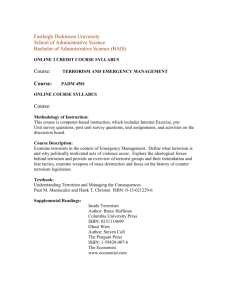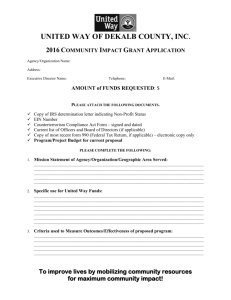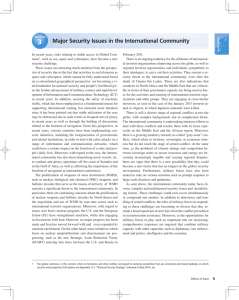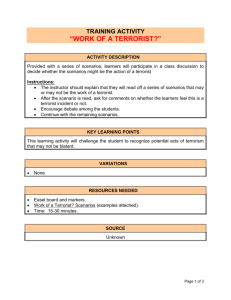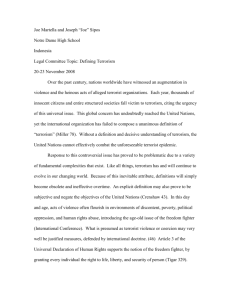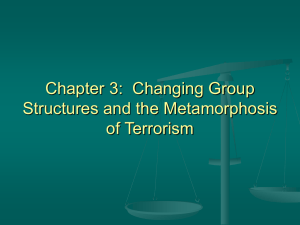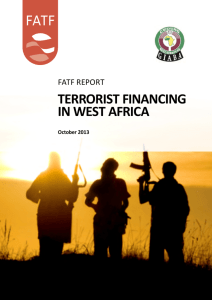Community Threat Assessment & Risk Analysis - Fdu
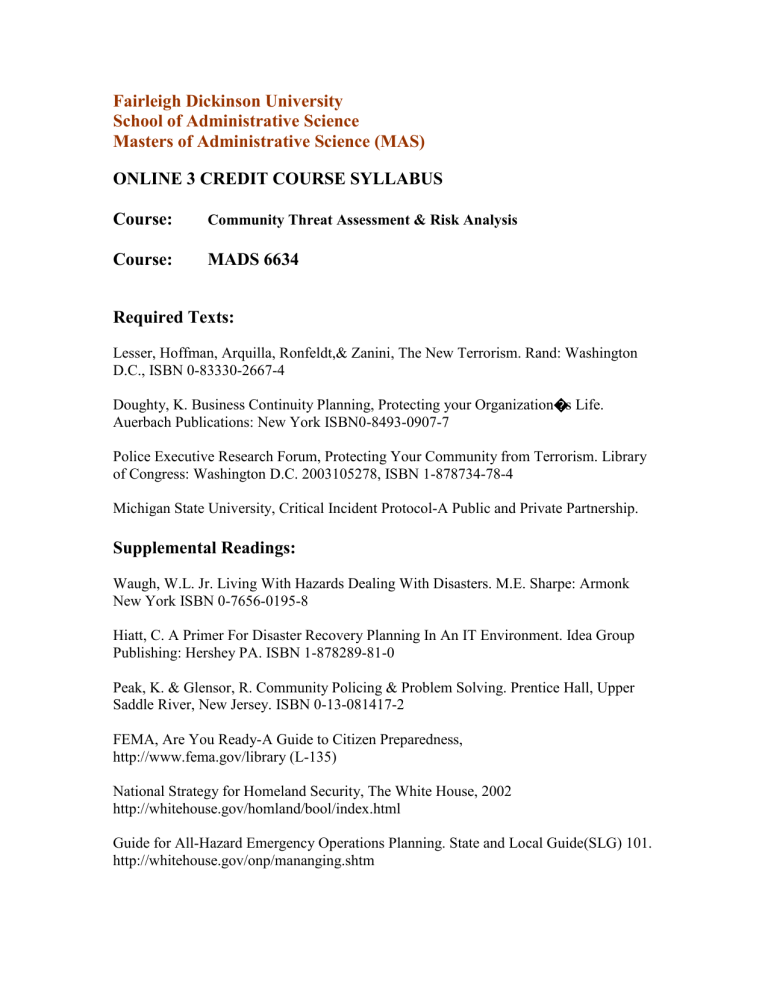
Fairleigh Dickinson University
School of Administrative Science
Masters of Administrative Science (MAS)
ONLINE 3 CREDIT COURSE SYLLABUS
Course:
Community Threat Assessment & Risk Analysis
Course: MADS 6634
Required Texts:
Lesser, Hoffman, Arquilla, Ronfeldt,& Zanini, The New Terrorism. Rand: Washington
D.C., ISBN 0-83330-2667-4
Doughty, K. Business Continuity Planning, Protecting your Organization
� s Life.
Auerbach Publications: New York ISBN0-8493-0907-7
Police Executive Research Forum, Protecting Your Community from Terrorism. Library of Congress: Washington D.C. 2003105278, ISBN 1-878734-78-4
Michigan State University, Critical Incident Protocol-A Public and Private Partnership.
Supplemental Readings:
Waugh, W.L. Jr. Living With Hazards Dealing With Disasters. M.E. Sharpe: Armonk
New York ISBN 0-7656-0195-8
Hiatt, C. A Primer For Disaster Recovery Planning In An IT Environment. Idea Group
Publishing: Hershey PA. ISBN 1-878289-81-0
Peak, K. & Glensor, R. Community Policing & Problem Solving. Prentice Hall, Upper
Saddle River, New Jersey. ISBN 0-13-081417-2
FEMA, Are You Ready-A Guide to Citizen Preparedness, http://www.fema.gov/library (L-135)
National Strategy for Homeland Security, The White House, 2002 http://whitehouse.gov/homland/bool/index.html
Guide for All-Hazard Emergency Operations Planning. State and Local Guide(SLG) 101. http://whitehouse.gov/onp/mananging.shtm
Course Goal:
By the end of this course students will be able to conduct a basic risk assessment for
Public Safety Officials, Business Leaders and Community Groups that identifies critical assets, determines relative risks and develops collaborative countermeasures that work in concert or independently to plan, mitigate, respond and recover from potential natural, man-made, and technological threats.
Class Requirements:
Attendance: Students must complete all eight units of on-line classes and respective work assignments for each class. Students will also be expected to complete pre and post module examinations in the order they are received.
Participation: Students are expected to e-mail questions, comments, and/or opinions at the completion of each module and are encourage to e-mail other students (CC: to instructor) and exchange ideas offered in the course materials. All student interaction related to the course material will be considered participation.
Mid-Term Exam: Students will be given an online midterm examination reviewing all modules prior to the exam. The test will include multiple choice and essay short answer formats.
Final Project: Conduct a risk assessment to identify a critical asset in their local community that is pre-approved by the course instructor, and to develop an appropriate counter-measure for Police, Business and the Community to mitigate the terrorist threat.
The Assessment process shall be conducted in accordance with the Risk Analysis protocols covered in the course materials and must follow a prescribed methodology.
You must be able to defend your assessment of the threat, and counter-measure selected to mitigate it.
Please do not e-mail a copy of your local community emergency plan prepared by municipal authorities or some other governmental agency. This will be considered plagiarism and the student will receive no credit for the final project which represents
40% of the overall grade.
Grading:
Attendance
Participation
10%
15%
Mid-term Examination 35%
Final Project 40%
Course Organization
Unit 1 Introduction to Community Threat Assessment & Risk Analysis
By the end of this unit, the participant will be able to: and the community to combat terrorism assessment ce in developing collaborative partnerships among first responders, businesses, and the community to form a unified approach to counterterrorism relates to the Community Oriented Police and Problem Solving program
Unit 2 Threat Assessment and Red-Teaming
By the end of this unit, the participant will be able to:
Define the concept of red-teaming
terrorist are domestically and internationally
weapons are available to terrorist groups including weapons of mass destruction (WMD)
terrorist may attack the United States (U.S.) again and discuss significant anniversary dates
State Where, or the likelihood of where, the next terrorist attack may occur
terrorist organizations resort to extreme tactics and the motivations of various terrorist groups
terrorist may perpetrate the next attack and discuss various attack scenarios based on current trends and case studies
Unit 3 Risk Assessment
By the end of this unit, the participant will be able to: assessment critical asset value to it assign a value from least to most vulnerable considered to be critical and vulnerable
Unit 4 Mitigation
By the end of this unit, the participant will be able to: ical security survey when evaluating the quality of physical counter-measures in place to prevent, detect, and/or interdict a terrorist attack combating terrorism
State the three important elements in constructing any effective physical countermeasures program to terrorism
-measures and ensure consistent operation, low error rate, and high proportionate reliability
Unit 5 Introduction to Disaster Recovery
By the end of this unit, the participant will be able to: to evaluate the response capability of area resources with respect to a terrorist attack and develop a mitigation plan in accordance with the Homeland Security Advisory System
measures to protect critical areas and reduce vulnerability from low to severe risk of terrorist attack protect critical areas and reduce vulnerability from low to severe risk of terrorist attack with respect to weapons of mass destruction (WMD) incidents to protect critical areas and reduce vulnerability from low to severe risk of terrorist attack with respect to WMD incidents and/or respond to a terrorist incident regardless of risk advisory
Unit 6 Preparedness
By the end of this unit, the participant will be able to:
Describe the Federal Emergency Management Agency (FEMA) State and Local
Guides 101 (SLG 101) used for emergency planning
-based, and all-hazard in approach of the national emergency system
State the basic elements to be included in an emergency plan and the functional annexes that serve as a basis for effective response to any hazard threatening a jurisdiction he steps necessary for developing, conducting, evaluating, and following-up an effective exercise characteristics and steps necessary in testing a jurisdiction’s emergency plan
Unit 7 Incident Command System
By the end of this unit, the participant will be able to: emergency incidents, especially incidents involving weapons of mass destruction (WMD) as specified in Homeland Security Presidential Directive 5 (HSPD-5)
California roots in the early 1970s
management system when confronted with the need to approach incident management/crisis management in a systematic way evaluation form and make judgments about their local community’s ability to implement the incident command system during an actual emergency
National Inter-agency Incident management System (NIIMS) and the National Response
Plan for incident management (NRP)
Unit 8 Business and Community
By the end of this unit, the participant will be able to: contingency planning as they relate to terrorism
Continuity Plan recognizing the similarities in identifying risk as well as the likelihood of an event that may constitute a business disaster nce of establishing partnerships with business and engaging in joint planning to achieve a common objective in the war on terrorism planning process to win the trust and confidence of each other and the mutual responsibilities that will affect partnerships
-Oriented Policing in developing partnerships with the community as part of the war on terrorism


